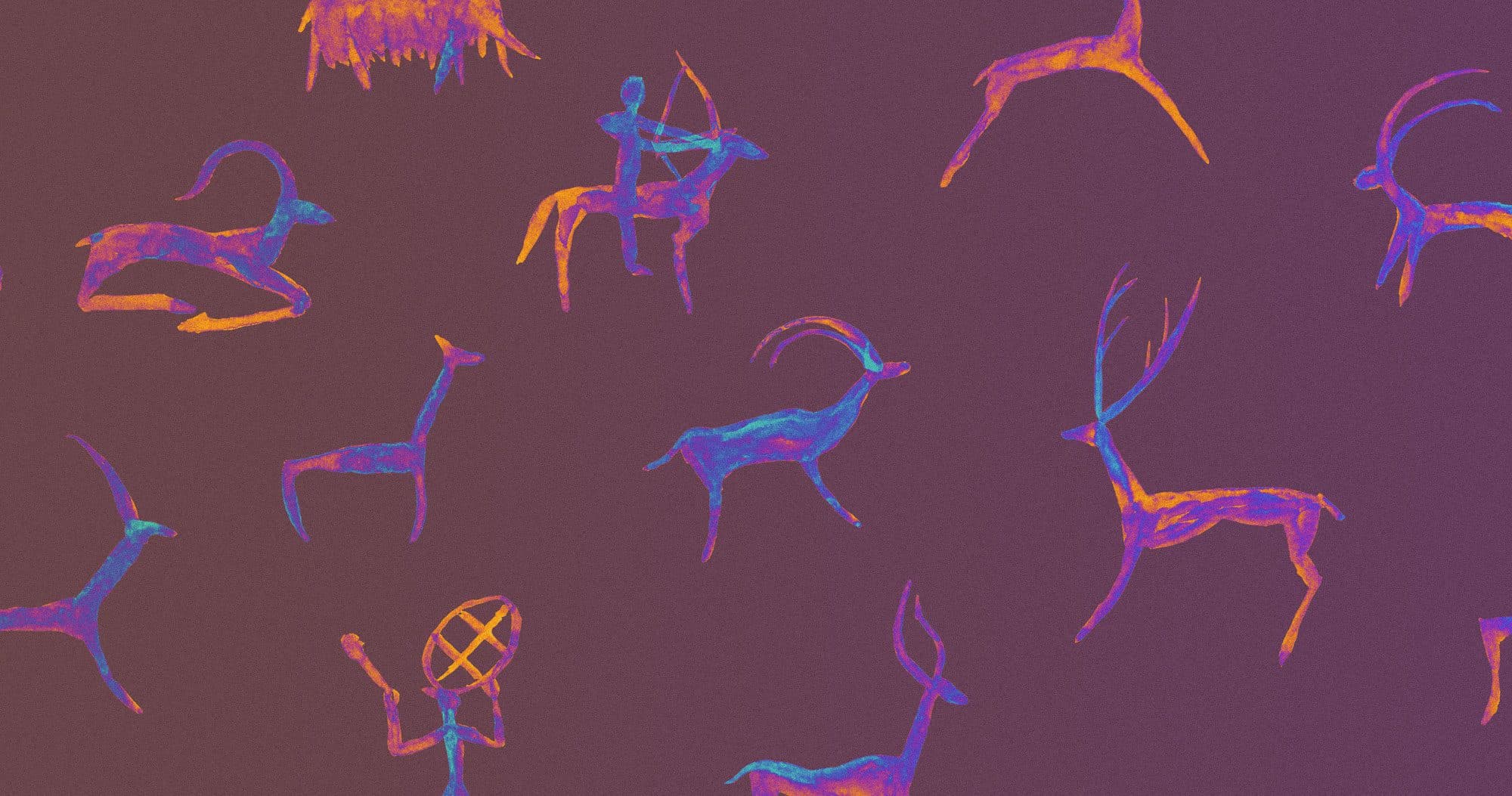Ancient Humans & Our DNA

Did you know that a group of owls is known as a parliament? Or that some snakes begin to develop legs as embryos, only to lose them before hatching? Science is full of quirky little fun facts that you can use to break the ice during awkward social moments and—if done correctly—to build your image as the cool party guest.
While tidbits about snakes and owls are interesting, it’s those revealing insights into our own species that can be the most surprising. So with that in mind, here’s three fun facts about humans that you can use to inspire others to take an interest in human history, and look cool doing it:
We Aren’t the Only Humans
The term “human” actually refers to any member of the genus Homo. Scientists studying the relationships between species have classified different organisms into discrete buckets. Homo contains multiple species including our own (Homo sapiens), Homo neanderthalensis, Homo floresiensis, and more. Each of these species is technically considered human.
There is more Neanderthal DNA in the world today than there was when Neanderthals were alive.
How could this possibly be true? As weird as it sounds, it all comes down to numbers. Neanderthals disappeared about 40,000 years ago. It’s challenging to know exactly how big the entire Neanderthal population was at any given time in history, but there are reliable ways to analyze DNA extracted from Neanderthal fossils to estimate their approximate population size1. At the high end, some researchers believe there may have been as many as 60,000 Neanderthals spread out across the Eurasian continent 2. Most estimates place the number much lower, however, often less than 10,000 reproductive individuals 1,3.
Even if the Neanderthal population was small, it was obviously bigger than it is today. Sometime after anatomically modern humans (Homo sapiens) left Africa, the Neanderthals disappeared. Genetic evidence suggests that at least some groups of Neanderthals merged with modern humans. As a result, many modern humans have some very distant Neanderthal ancestry. In fact, most people without recent African ancestry have inherited about 1-4% of their DNA from Neanderthals. With about 6 billion people falling into this category, that means there’s the equivalent of about 60 million to 240 million individuals’ worth of Neanderthal DNA in the world today. That’s a lot more than 60,000!
8 Things to Know About our Ancient Relatives

The Neanderthals are practically celebrities of the ancient world. There’s this mysterious air about these ancient people—who were they, and how did we interact with them? These questions have been the topic of ongoing research, and the results depict a fascinating story involving Neanderthals, the related Denisovans, and modern humans.
Here’s what you need to know:
1. Neanderthals and Denisovans were humans!
In the same way that a Rottweiler and a Corgi are both dogs, Neanderthals and Homo sapiens were both humans. It’s hard to imagine, but after hundreds of thousands of years spent apart—while separated by continents—Homo sapiens and Neanderthals began to evolve into different species. But before they could, their paths crossed again and a single human species emerged.
2. Their names come from the location of their discovery
Neanderthals were first discovered in a cave located in the Neander Valley of Germany. Denisovan remains were first found in the Denisova Cave in the frigid mountains of Siberia.
3. Eurasia was home to Neanderthals and Denisovans for nearly 300,000 years before Homo sapiens showed up
Neanderthal remains have been found in Eurasia that date back as far as 450,000 years. In contrast, the earliest recorded Homo sapiens remains outside of Africa date to about 100,000 years ago.
4. Neanderthals and Denisovans were better adapted to northern climates
With hundreds of millenia spent on the Eurasian continent, Neanderthals and Denisovans began to evolve in ways that helped them survive the colder weather and varied amounts of sunlight. Archeological data suggests they were shorter and stockier, and genetic analysis indicates they had a wide variation in pigmentation of their hair and skin. Some adaptations may have also helped them make more of a heat-producing type of fat to help them in colder weather.
5. It’s not clear what happened to them
Homo sapiens ventured beyond Africa about 100,000 years ago. By 40,000 years ago, the Neanderthals and Denisovans had disappeared. There have been competing theories for what caused their disappearance. Until recently, it was believed that war and competition with Homo sapiens lead to their demise. But recent evidence indicates that they may have just merged cultures with Homo sapiens.
6. Neanderthals, Denisovans, and Homo sapiens weren’t the only humans
With improved sequencing and computational power, researchers are finding evidence that people of African ancestry may have inherited archaic DNA from other, non-Neanderthal humans. Ongoing research aims to clarify the dynamic flow of genetic data between groups in ancient Africa.
7. Neanderthals, Denisovan, and other archaic DNA lives on in modern humans
Genetic analysis shows that there was a dynamic flow of genetic material between Homo sapiens and other archaic humans. Analysis of modern and ancient DNA tells us that Denisovan and Neanderthal DNA entered the Homo sapiens gene pool somewhere between 40,000 and 65,000 years ago and has persisted ever since. Now, about 2-6% of the DNA in people of non-African ancestry comes from Neanderthals or Denisovans. Current research is looking to learn more about archaic humans in Africa and how their DNA may or may not be affecting us today.
8. Learning about Neanderthal and Denisovan DNA is easier than you think
Learning about archaic humans isn’t just about history, it can also be a personal look back at your family’s history. DNA sequencing can help you explore your DNA for traces of Neanderthals and Denisovans.
What can corgis teach us about Neanderthals?

The concept of a species is something we often assume as set in stone—once a species, always a species. But the recent news of the sequencing of an ancient human hybrid reminds us that the process of defining a species, even our own, is rarely straightforward.
Coming in at 12 inches tall and weighing approximately 30 pounds, the Pembroke Welsh Corgi has become a towering celebrity (figuratively speaking) amongst dog lovers. Watching corgis galavant down city streets, it’s hard to believe they’re related to timber wolves, much less that they’re the same species. Archeological and genetic research tell us that dogs have been living apart from wolves for at least 20,000 years, slowly evolving new traits along the way 7. But even after all this time, it’s still possible to get a viable and fertile dog-wolf hybrid, which is why wolves and corgis are classified as the same species.
This definition of “species”—which we still commonly use today—was first introduced in 1942 by the zoologist Ernst Mayr, calling them “groups of actually or potentially interbreeding natural populations which are reproductively isolated from other such groups.” To put it another way, a species can be defined as a group of animals that are capable of producing viable and fertile offspring 8,9.
DNA sequencing data challenges the idea that they were a different species
Though this is a popular definition, it’s not the only one 8-10. Determining whether two animals could mate is challenging when the animals only coexisted 200,000 years ago. For this reason, the definition of a species proposed by Mayr doesn’t work well for scientists studying the fossils of ancient humans. Instead, they’ve classically relied on grouping extinct species based on defining characteristics—such as a unique skull, jaw, or pelvic shape. This method is how scientists managed to describe different species of human beings.
What we know as anatomically modern man, or Homo sapiens sapiens, first appeared in Africa around 200,000 years ago 11. At that point in time, Neanderthals and Denisovans were well established in Eurasia, having already lived there as distinct groups for at least a few hundred thousand years 11. Although all three groups can be classified as humans, archeological data showed that Neanderthals and Homo sapiens sapiens were different. Not only did they evolve in different parts of the world, they also had distinctive bone structures. Taken together, this was enough information for scientists to classify Neanderthals as a species separate from our own. But with the advent of DNA sequencing, the line dividing Homo sapiens sapiens from Neanderthals has become blurred.
Is Homo sapiens sapiens a typo?
Surprisingly, it’s no typo. Typically, we refer to ourselves as just Homo sapiens, however that’s not our full name. Modern humans have been classified as a subspecies of Homo sapiens known as Homo sapiens sapiens.
This is to set us apart from other subspecies, like Homo sapiens neanderthalensis—more typically referred to as just Neanderthals. This is similar to how dogs are Canis lupus familiaris while wolves are Canis lupus lupus.
DNA sequencing of modern humans has shown that about 2% of most people’s DNA is from some form of archaic human—Neanderthals, Denisovans, or other unknown species 12,13. It was once thought that Homo sapiens sapiens replaced Neanderthals in Eurasia by driving them to extinction shortly after leaving Africa. However, the common occurrence of archaic DNA in modern humans indicates that at least some Neanderthals assimilated with Homo sapiens sapiens approximately 50,000-80,000 years ago 14. This leads to two conclusions: First, that while the arrival of modern humans may have pushed towards the extinction of Neanderthals and Denisovans, it was not a simple replacement; and second, that Homo sapiens sapiens and these other human species could produce viable offspring—challenging the very idea that they were different species.
This understanding of how Homo sapiens, Neanderthals, Denisovans and other ancient human groups are related to one another is still unfolding as DNA sequencing methods continue to improve. Just this month, scientists announced the sequencing of an ancient human hybrid whose DNA was half Neanderthal and half Denisovan 15. This DNA sequence provided hard evidence that these two species of human could produce children. According to Mayr, the ability to produce reproductively viable children is only possible between members of the same species. While it’s not currently possible to say whether this individual was fertile, the discovery of this hybrid combined with the presence of archaic DNA in modern humans remind us that we are more similar than we once thought. Perhaps one day we’ll look at Neanderthals as the archaic wolves to our modern corgi.
How are we related to hobbits?

Nowadays, the Liang Bua cave overlooks lush farmland. High above its ceiling, trees blanket the hillside as if they were deliberately trying to hide the island’s violent volcanic beginnings. It’s hard to know what events lead up to her demise, but it’s likely that here, in the shelter of this cave—with a view of the sprawling valley before it—a hobbit took her final breaths of life.
When we think of human history, we often picture a linear progression where primitive beings exist for a time, only to give way as more sophisticated humans develop. And so it goes up to the modern day. This view isn’t necessarily wrong, but it does gloss over some pretty incredible moments in our history—including the evolution of the hobbits.
In 2004, researchers described the discovery of multiple ancient human-like skeletons in the Liang Bua cave, located on the island of Flores in Indonesia 16,17. The remains belonged to beings who had occupied the cave as recently as 50,000 years ago, with the oldest skeleton among them dating back about 95,000 years 16-18. But what was truly exceptional about these skeletons was how different they were compared to other ancient human remains in that part of the world—these beings were remarkably small, had disproportionately long arms, and stood on particularly long feet. In other words, they looked like hobbits. Adding to their curious features was the finding that they likely had unusually small brains. Despite having small brains, there is substantial evidence showing that the hobbits had the cognitive competence to make and use tools. Taken together, the short, disproportionate stature and small, but cognitively proficient brains of the hobbits were unexpected and set off a storm of arguments in the scientific community that continues to this day 17,19.
The argument centers around whether the hobbits of Flores represent ancient humans, or an even older, human-like species. This is important because the answer to this question could potentially rewrite human history.
Currently, it’s believed that around 2 million years ago, the species that came before us (Homo erectus) left Africa and entered the Eurasian continent, marking the first time any human species left Africa. Over time, they spread across the continent and may have contributed to the ancestry of Neanderthals and Denisovans, and therefore to many modern humans today. Groups of Homo erectus that stayed in Africa eventually gave rise to Homo sapiens and modern man 17,20.
One viewpoint argues that a Homo erectus group living in Indonesia approximately 800,000 years ago may have migrated to the island of Flores, where they became isolated from the mainland population. As a result of the unique evolutionary pressures on the island, this group could have evolved into the hobbits. There is substantial evidence supporting this viewpoint, which includes hobbit-like remains located on the island of Flores that are approximately 700,000 years old 17,19,21. However, Homo erectus had a large brain, causing some to question whether the hobbits could really have evolved from Homo erectus 17.
A competing theory suggests that the hobbits developed from a hominid species that predates Homo erectus. Archeological findings in Africa show us that the predecessors to Homo erectus were smaller in stature and had smaller brains. It is possible—though no evidence currently exists to support it—that these early hominids left Africa and made their way to Indonesia. Once on Flores, their isolation from the mainland population may have preserved their primitive features 17. If this were the case, it would mean that human-like species left Africa much earlier than we are aware.
Debate over the origins of the hobbits’ features is intense, and fueled partly by the relative scarcity of material for scientists to study 17. There’s just not that many skeletons and other kinds of material evidence. We do know that they were able to make tools and fire thanks to the discovery of charred bones and ancient, fire-cracked rocks in the Liang Bua cave 17. We also know that they weren’t alone on the island. Archeological findings tell us that the hobbits lived alongside miniature elephants (Stegodon florensis insularis), gigantic rats, komodo dragons, and a crane-like carnivorous bird that stood six feet tall 22,23. The presence of these exotic creatures could give us some clues about the hobbits’ origins.
Isolation on an island can lead to dramatic evolutionary change. The elephants of Flores are good examples. In the wake of a cataclysmic volcanic eruption approximately 900,000 years ago, the island became inhabited by new life including Stegodons from nearby islands 22,23. Large animals may sometimes evolve away from having a large body in the absence of significant predators. Small islands usually have limited resources, so evolution may favor smaller body types that require less energy. This may be why the Stegodons shrank. Recent modeling suggests that, if Homo erectus did colonize the island, it could have been evolutionarily favorable for them to develop smaller bodies—eventually leading to evolution of the hobbits 19,22,23.
Ultimately, the hobbits’ unique features lead to their designation as a bona fide species, officially called Homo floresiensis. These early humans highlight the branching nature of evolution and remind us that our history is far from being a simple, ordered path from primitive to modern. It will be interesting to see what comes to light in the future as studies continue to explore the origin of these ancient cousins of ours.
Citations
- Prüfer, Kay et al. “The Complete Genome Sequence of a Neandertal from the Altai Mountains.” Nature 505.7481 (2014): 43–49. PMC. Web. 19 Oct. 2018.
- Roebroeks, Wil, and Marie Soressi. “Neandertals Revised.” Proceedings of the National Academy of Sciences of the United States of America 113.23 (2016): 6372–6379. PMC. Web. 19 Oct. 2018.
- Rogers, Alan R., Ryan J. Bohlender, and Chad D. Huff. “Early History of Neanderthals and Denisovans.” Proceedings of the National Academy of Sciences of the United States of America 114.37 (2017): 9859–9863. PMC. Web. 19 Oct. 2018.
- Marciniak, Stephanie, and George H. Perry. “Harnessing Ancient Genomes to Study the History of Human Adaptation.” Nature Reviews Genetics, vol. 18, no. 11, Nov. 2017, pp. 659–674., doi:10.1038/nrg.2017.65.
- Kozowyk, P. R. B. et al. “Experimental Methods for the Palaeolithic Dry Distillation of Birch Bark: Implications for the Origin and Development of Neandertal Adhesive Technology.” Scientific Reports 7 (2017): 8033. PMC. Web. 19 Oct. 2018.
- Cârciumaru, Marin, et al. “New Evidence of Adhesive as Hafting Material on Middle and Upper Palaeolithic Artefacts from Gura Cheii-Râşnov Cave (Romania).” Journal of Archaeological Science, vol. 39, no. 7, 2012, pp. 1942–1950., doi:10.1016/j.jas.2012.02.016.
- Lallensack, Rachael. “Ancient Genomes Heat up Dog Domestication Debate.” Nature, 2017, doi:10.1038/nature.2017.22320.
- Hey, J. “On the Failure of Modern Species Concepts.” Trends in Ecology & Evolution, vol. 21, no. 8, 8 June 2006, pp. 447–450., doi:10.1016/j.tree.2006.05.011.
- Aldhebiani, Amal Y. “Species Concept and Speciation.” Saudi Journal of Biological Sciences 25.3 (2018): 437–440. PMC. Web. 30 Aug. 2018.
- Baker, Robert J., and Robert D. Bradley. “SPECIATION IN MAMMALS AND THE GENETIC SPECIES CONCEPT.” Journal of mammalogy 87.4 (2006): 643–662. Print.
- Nielsen, Rasmus et al. “Tracing the Peopling of the World through Genomics.” Nature 541.7637 (2017): 302–310. PMC.
- Marciniak, Stephanie, and George H. Perry. “Harnessing ancient genomes to study the history of human adaptation.” Nature Reviews Genetics, vol. 18, no. 11, Nov. 2017, pp. 659–674., doi:10.1038/nrg.2017.65. Web. 30 Aug. 2018.
- Hammer, Michael F. et al. “Genetic Evidence for Archaic Admixture in Africa.” Proceedings of the National Academy of Sciences of the United States of America 108.37 (2011): 15123–15128. PMC. Web. 30 Aug. 2018.
- Sankararaman, Sriram et al. “The Date of Interbreeding between Neandertals and Modern Humans.” Ed. Joshua M. Akey. PLoS Genetics 8.10 (2012): e1002947. PMC. Web. 14 July 2018.
- Slon, Viviane, et al. “The Genome of the Offspring of a Neanderthal Mother and a Denisovan Father.” Nature, 2018, doi:10.1038/s41586-018-0455-x.
- Brown, P., et al. “A New Small-Bodied Hominin from the Late Pleistocene of Flores, Indonesia.” Nature, vol. 431, no. 7012, 2004, pp. 1055–1061., doi:10.1038/nature02999.
- Aiello, Leslie C. “Five Years of Homo Floresiensis.” American Journal of Physical Anthropology, 2010, doi:10.1002/ajpa.21255.
- Brumm, Adam, et al. “Age and Context of the Oldest Known Hominin Fossils from Flores.” Nature, vol. 534, no. 7606, 2016, pp. 249–253., doi:10.1038/nature17663.
- Diniz-Filho, José Alexandre Felizola, and Pasquale Raia. “Island Rule, Quantitative Genetics and Brain–body Size Evolution in Homo Floresiensis.” Proceedings of the Royal Society B: Biological Sciences 284.1857 (2017): 20171065. PMC. Web. 20 Sept. 2018.
- Michel, Véronique et al. “New Dating Evidence of the Early Presence of Hominins in Southern Europe.” Scientific Reports 7 (2017): 10074. PMC. Web. 21 Sept. 2018.
- Bergh, Gerrit D. Van Den, et al. “Homo Floresiensis-like Fossils from the Early Middle Pleistocene of Flores.” Nature, vol. 534, no. 7606, 2016, pp. 245–248., doi:10.1038/nature17999.
- Sutikna, Thomas, et al. “The Spatio-Temporal Distribution of Archaeological and Faunal Finds at Liang Bua (Flores, Indonesia) in Light of the Revised Chronology for Homo Floresiensis.” Journal of Human Evolution, 2018, doi:10.1016/j.jhevol.2018.07.001.
- Meijer, Hanneke J. M., et al. “The Fellowship of the Hobbit: the Fauna Surrounding Homo Floresiensis.” Journal of Biogeography, vol. 37, no. 6, 2010, pp. 995–1006., doi:10.1111/j.1365-2699.2010.02308.x.